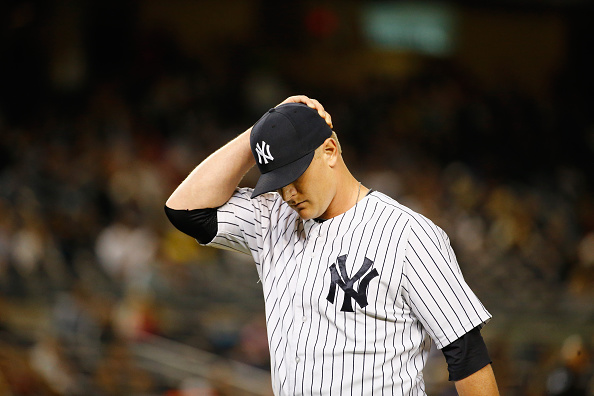David Carpenter has been tantalizing Yankees fans this season. Coming off of successful seasons in Atlanta in which he posted 1.78 and 3.54 ERAs in 2013 and 2014, respectively, the righty reliever hasn’t lived up to expectations, to say the least. He’s posted a 5.00 ERA in 18 innings so far—and that doesn’t even take into consideration the bases-loaded walk Carpenter allowed on Thursday night against Oakland. All of this begs the question: what exactly is wrong with David Carpenter?
Carpenter’s stuff doesn’t seem to have declined. He is throwing slower than last year, but only slightly so—96.6 MPH in 2014 vs. 95.9 MPH in 2015. Likewise, the movement on both his fastball and slider remains nearly identical. Yet it doesn’t appear that he’s been unlucky, either. Carpenter’s opponents’ batting average on balls in play is just about a league-average .296 according to Baseball Reference, and his FIP of 5.39 is even higher than his ERA. Carpenter’s not giving up all that many more hits than he did last year, as he averaged little more than a hit per inning both last season and this season. He’s also inducing more ground balls than ever, which usually bodes well for pitchers. However, it hasn’t in Carpenter’s case.
Yet, Carpenter’s K/9 of 9.9 in 2014 has plummeted to a sub-par 5.5 this year. Additionally, he’s already allowed three home runs in the young season. For reference, he allowed five total in each of the past two seasons. It’s possible that Carpenter has merely gotten unlucky in this regard, and that these home run numbers will stabilize. Even accounting for that, however, doesn’t tell the whole story. xFIP—which stabilizes pitchers’ home runs allowed rates—still gives Carpenter a 4.74.
Much of Carpenter’s struggles can be accounted for by his control. His BB/9 rate has shot up to 3.5 from 2.4 last season, causing him to put more batters on base every inning. He’s throwing significantly fewer strikes overall—his strike percentage has declined from 69.2% last season to 63.0%. The number of pitches that he’s thrown in the “zone”—ignoring whether or not batters swung at them—has also declined, by 5.3%. Perhaps the most dramatic change in this regard has been Carpenter’s first-pitch strike percentage, which has gone down to 55.7% from 69.9%, causing Carpenter to have to pitch from behind in many counts.
Yet, bizarrely, even when Carpenter gets ahead of batters, he hasn’t been able to put them away. When the count is in Carpenter’s favor, batters have notched a .895 OPS against him. Of course, he doesn’t fare well when he’s behind batters, either, as they’ve hit 1.214 in those situations. In particular, Carpenter does poorly when he has one strike on a batter early in the count. 7 of the 19 hits Carpenter has allowed this season have come on an 0-1 or 1-1 count. His inability to get past these counts partially explains his decline in strikeouts, as does his reduced command.
Carpenter has also struggled because of the hard contact he’s given up. When they do swing at pitches, batters aren’t making more contact against him than they did last season. In fact, they’re making less. As Carpenter’s BABIP shows, they’re not getting unnaturally lucky when they hit the ball, either. It does seem, however, that when they hit the ball, they hit it hard. 8 of the 19 knocks Carpenter has allowed this season have been extra-base hits. Additionally, by Baseball Info Solutions’ “Hard%” metric, Carpenter has allowed the seventh-highest amount of “hard” contact on his pitches among MLB relievers.
Even after all of these words, Carpenter’s reduced performance has been head scratching. The best explanation I can fathom is simply that Carpenter’s lost some command, which has caused his increased number of walks. I hypothesize that it’s also caused him to make more mistakes—meaning, it’s caused him to groove more pitches, which is why the hits he’s allowed have been so damaging. If Carpenter is to get back on track and become the pitcher the Yankees thought they were acquiring last winter, his command will be the key.






